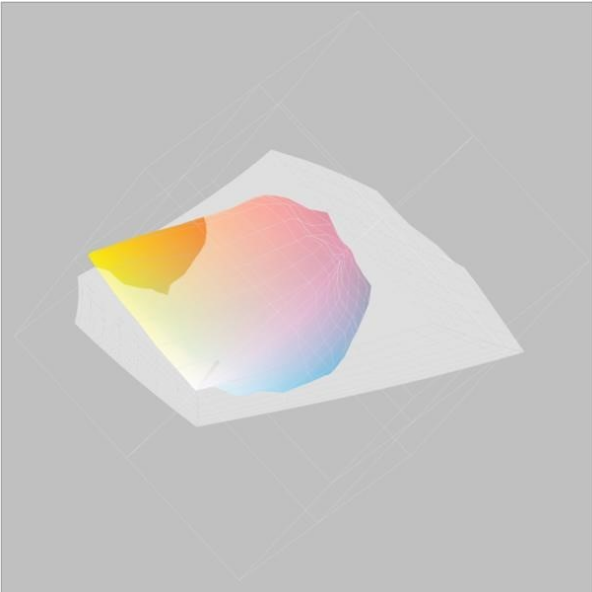The exact reproduction of brand colors is a particular challenge, since in addition to the visual appearance, the most precise metrological adherence to the specifications is also essential for this. The requirements are often extremely complex, because it is not always possible to ensure that the desired color can even be output on the existing output system with the required accuracy.
Brand colors are ideally created as "spot colors" in the relevant print jobs and are optimally specified via L*a*b* or spectral values. These often come from a color library. Providers of such libraries are, among others, PANTONE®, HKS® and RAL, and there are also systems such as "freieFarbe e.V." that offer free color libraries.
DISADVANTAGES OF COLOR DEFINITION IN CMYK, RGB OR HEX VALUES
In addition, replacement values can be found on the internet for various brand colors, which are specified in CMYK, RGB or HEX values. Color reproduction based on these values, however, has some disadvantages:
The HEX values refer to the color representation commonly used on the internet, based on an s-RGB representation. These are at best suitable as a rough guide for print production.
The RGB values offered mostly refer to the s-RGB color space, like the HEX values. Yet the s-RGB color space is typically much larger than the color space that can be printed on real substrates.

Here you can see a typical color space from textile printing (inside, colored) and in s-RGB (outside, gray).
A much larger color space can be represented in s-RGB than in the given textile printing - however, the s-RGB color space does not necessarily contain every color that can be represented in terms of printing technology in textile printing.
Replacement values for the definition of brand colors are often also specified in CMYK. Here, too, the same applies as for RGB: Without an ICC profile as a reference, this value is completely meaningless. In principle, depending on the reference profile, a single CMYK or RGB value can be used to represent any color.
Another problem with all color spaces defined in RGB or CMYK is that these are device-dependent color spaces, i.e. color spaces that relate to a specific device under precisely specified conditions. Therefore, to enable reliable color communication, it is mandatory to define colors of a device-independent color space (L*a*b* values or spectral values).
In summary, we can state that with RGB, CMYK or HEX values, brand or spot colors cannot be reproduced exactly; instead, L*a*b* values or spectral values must be used.
RELIABLE COLOR DEFINITION in Productionserver
This is where ColorGATE Productionserver comes into play: depending on the license, it supports both spot colors in the L*a*b* color space - the current libraries from PANTONE® may be included in the scope of delivery - and color libraries with spectral entries, e.g. PantoneLIVE® (you can use these in Productionserver if you have a corresponding Pantone license).
In addition, the libraries from "freieFarbe e.V." are provided during the installation of Productionserver, many color libraries from other suppliers can also be integrated. On request, we may also provide you with RAL libraries. Of course, you can also build your own color libraries; all you need is a spectrophotometer to measure the reference colors.
In practice, then, it's really simple: Productionserver gives you the option of automatically including spot colors from libraries in the print jobs. Alternatively, you can also assign these color values to the corresponding colors manually.
In this way, you have created the prerequisite for the use of spot colors. In the second step, color replacement then takes place via the name assigned to the respective color or via the defined L*a*b* value.
In order to enable a usable preview or screen display, the colors created in this way usually have a CMYK or RGB replacement value, which, however, cannot be used to achieve exact color accuracy, as explained above.
For optimum reproduction results, please note in advance that the prerequisite for any accurate color reproduction is always an exact characterization of the output process. Without ICC profiling - which describes the properties of the inks, the printer's operating mode and the substrate to be printed on - any attempt at accurate color reproduction becomes a time-consuming trial-and-error process. On the other hand, however, it is advisable to keep the number of profiles used as low as possible so that the production environment still remains easily manageable. So the rule here is: as little as possible, as much as necessary.
And if nevertheless a desired color cannot be achieved with sufficient accuracy in print, simply use our Color Atlas Module, which may be optionally available in Productionserver. This allows you to print a selection of sample colors from which you can choose the color with the best possible visual match.
We wish you much success and optimal results when reproducing brand colors!
If you have any further questions, we will be happy to help you. Simply contact us at contact@colorgate.com.
0 Likes


